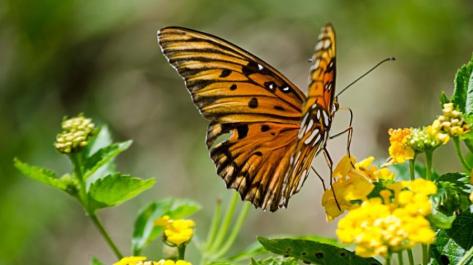NUMC - Being a Good Neighbor for the Butterflies

Monarchs (and butterflies in general) really are remarkable. There is just something magical about a butterfly. How does such a beautiful creature evolve from such a creepy, crawly one? Through an incredible process caterpillars are able to transform into one of God’s most beautiful creations. In some cultures, caterpillars are considered a delicacy to eat but I think I’ll pass on trying out that little treat. I had a Basset Hound one time that ate several caterpillars, it wasn’t a pleasant outcome for either of us and also involved a trip to the veterinarian, but that is a story for another time. We really need the caterpillars to survive and evolve into butterflies instead of its fate being the object of a curious Basset Hound who thinks everything is food.
The monarch butterfly population unfortunately is rapidly declining. It’s estimated that 90% of monarch eggs that are laid do not survive to adulthood. This is due to environmental factors such as drought, loss of habitat, pesticide use and natural predators. The most critical reason for their decline is the lack of milkweed available for them to keep reproducing. Milkweeds are the required host plants for monarch butterfly caterpillars (female monarchs only lay their eggs on milkweeds, no place else) and their flowers provide nectar for bees, butterflies, and other beneficial insects.
The monarch butterfly migration across the continent provides an invaluable service. It is thanks to these pollinators, such as butterflies, bees, and other insects, that we have many of the flowers and foods that we enjoy. Taking cues from the environment, the monarchs know when it is time to travel south for the winter. Some fly as far as 3,000 miles to reach their winter home! The monarch migration is an amazing process. Monarchs typically live from 2 to 6 weeks except for the last generation of the year, which can live up to 8 to 9 months. It is the fourth or fifth generation of monarchs each year which actually migrate to Mexico in late August or September. The ones that migrate live longer, from August or September to about April (although a lot also die before this).
The monarch does not live long enough to come back to where they were hatched, but their descendants do. At the end of the winter, they begin to travel north. They migrate north as far as they can, lay eggs and die, with their descendants repeating the process as they continue the trip north. Although it takes just one generation of monarchs to make it south to Mexico for the winter, it takes multiple generations, typically three or four, of the butterflies to return to their nesting grounds each spring. In the spring, monarchs must go where milkweed is immediately available because of the urgent need to reproduce before their lives end.
Did you know that Northfield is part of the I-35 Monarch Highway? This is the migration path that monarch butterflies take. We are lucky here at NUMC, as we have a neighbor of the church, Julianne, who is involved in monarch recovery. Julianne collects the monarch eggs in the spring off milkweed, raises them, tags them and then releases them to the wild. She shares with us how she got started in monarch recovery.
“In 2014 I saw a Monarch butterfly on a zinnia in my garden. Then while hosting a garage sale, I saw a Monarch eclose (the process in which a monarch comes out of its chrysalis) right in front of me! I started looking for caterpillars and raised a few in an old aquarium. I googled “Monarch butterflies” and fell into the rabbit hole of information! Now, years later I have raised countless butterflies and created a garden full of milkweed and flowers for them.
During those years I started to tag them in the fall. It is for research that the University of Kansas does. The Monarchs travel some 2000 miles to winter in the Oyamel trees in Mexico. In late January 2019 a friend and I traveled there to see them in the sanctuaries. We rode up the mountain on horses lead by guides. In the late spring researchers travel to Mexico to collect the tags that were found. The guides get $5 for each one found with a tag. Of the 1400 or so butterflies I have tagged, 4 have been found! It is very exciting to get the news!
The Monarchs have lost a lot of habitat and their numbers are declining. The best thing we can do is stop using chemicals on our lawns and gardens. Let the milkweed grow in your yard because that is the only place they lay eggs and it is the only food the caterpillars eat. Plant flowers for the butterflies to nectar on. They love Tithonia, Zinnias and Liatris.
On Saturday, September 9th, the Minneapolis Monarch Festival happens at Lake Nokomis. Music, dancing, food, demonstrations, art and information! Lots of kids’ activities too.“
So, what can we do to help the Monarchs? Plant native milkweed and provide nectar-rich plants, which creates a habitat to attract the monarch. We can also refrain from using pesticides. You may have noticed that we have milkweed growing on the NUMC campus. This is to provide food for the monarchs and a place for them to lay their eggs. Also, this year our facilities team is using a natural mixture of vinegar, Dawn dish soap and salt to kill the weeds and grass growing in the cracks of the parking lot instead of pesticides. These are both ways that we can be good stewards of nature as well as a good neighbor.
The butterfly is a symbol of transformation, hope and faith as it goes through so many life cycles, from larva to caterpillar to chrysalis and finally to a beautiful, flying butterfly. The monarch butterfly fills us with a sense of wonder and amazement. I find that watching a monarch gracefully flutter through the air is relaxing and soothing. But beyond its beauty, the monarch butterfly holds a deeper significance. The monarch serves as a reminder of how all living things are connected and about the importance of preserving our natural world for future generations. Sandy Vesledahl - NUMC Office Administrator
